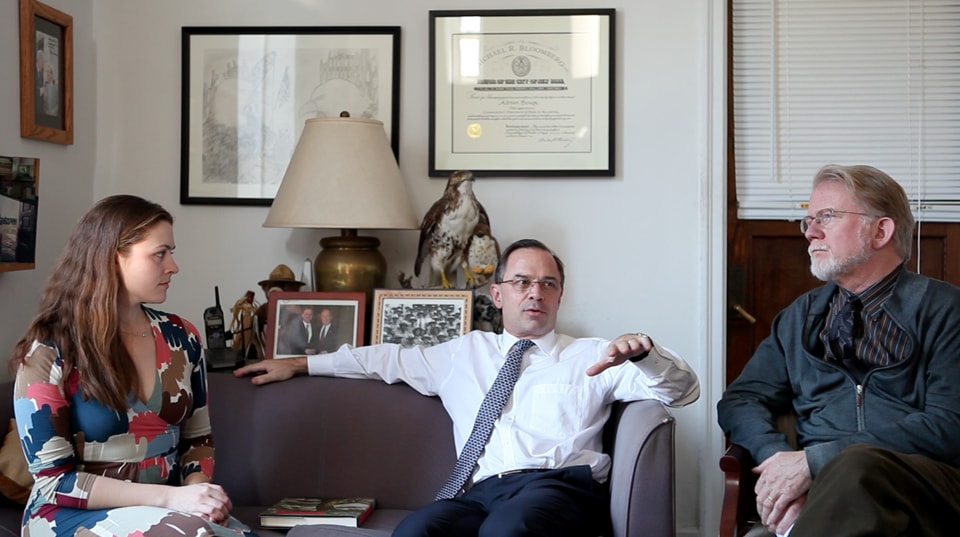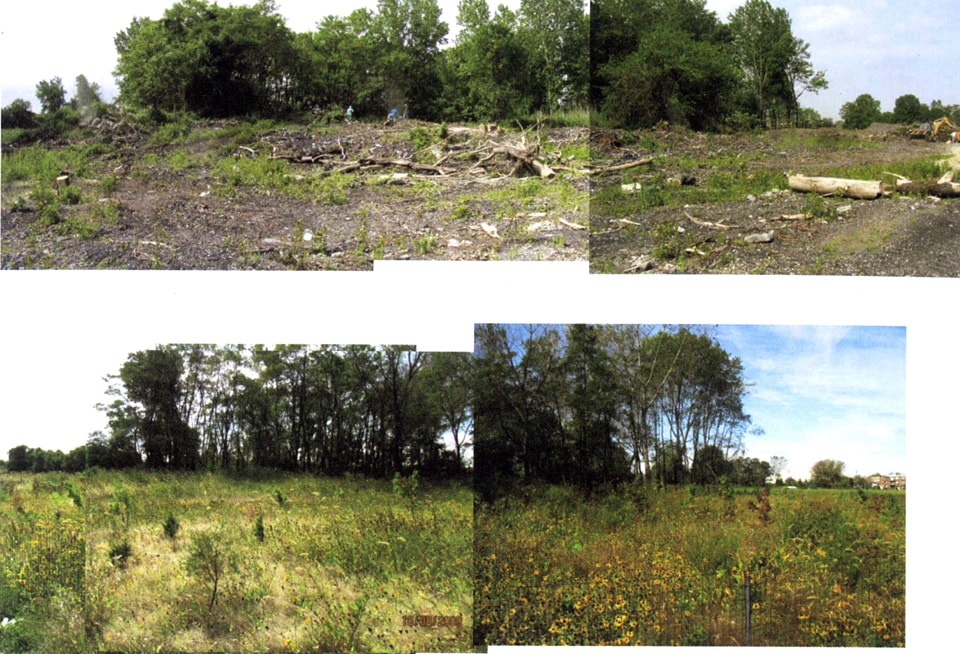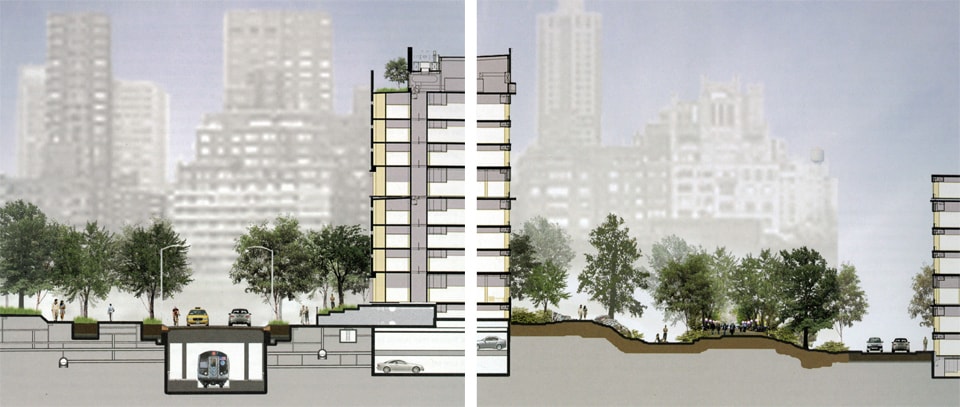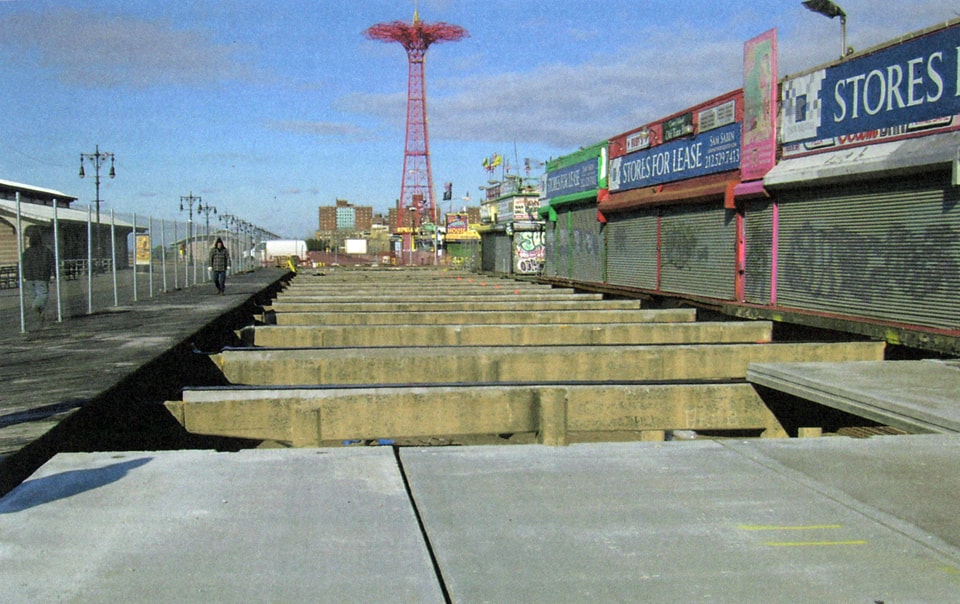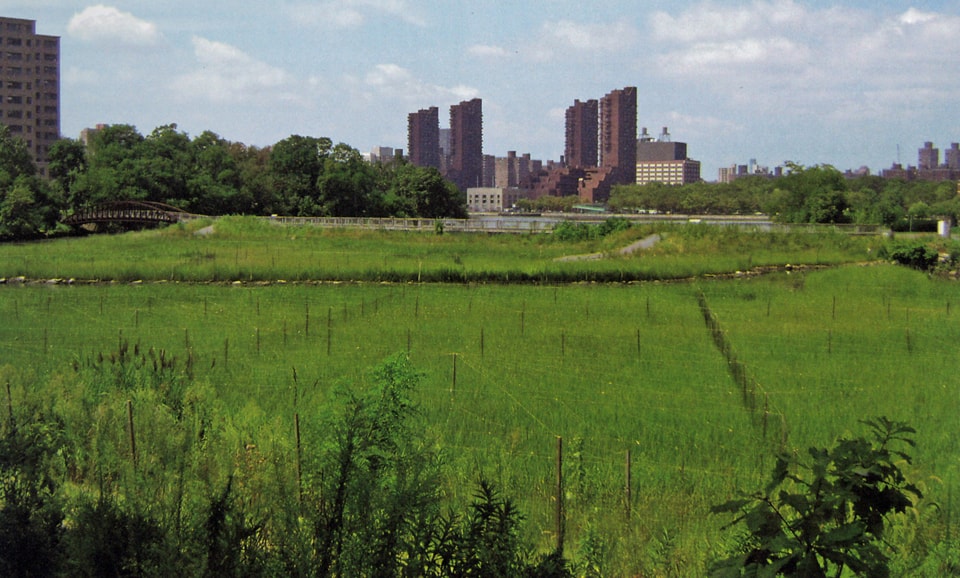“Parks are a crucial component of the urban infrastructure that will help our city address the challenges of the twenty-first century…With High Performance Landscape Guidelines, we’ve created a new blueprint for how parks are designed, built, and maintained.”
– Mayor Michael R. Bloomberg
Image by Angus McCullough
Produced through a collaboration between the New York City Department of Parks & Recreation and the Design Trust for Public Space, High Performance Landscape Guidelines: 21st Century Parks for NYC is a comprehensive design manual for a new generation of parks and public landscapes. The Guidelines weave together current research and best practices for design, construction and maintenance of parks and open space, and brings together leading expert knowledge on soil, water management and vegetation in order to comprehensively address the full range of ecosystem services and landscape performance – including social, ecological and economic factors.
The High Performance Landscape Guidelines is the third publication in The Design Trust’s ongoing series, following the publication of the High Performance Building Guidelines (1999) and the High Performance Infrastructure Guidelines (2005). The Design Trust, a nonprofit think tank dedicated to improving public space for all New Yorkers, supported and facilitated the project, bringing their long experience in engaging multiple stakeholders and government entities. The Trust recruited and funded an interdisciplinary team of landscape architects, engineers and sustainability experts. These Design Trust Fellows : Michele Adams, Steven Caputo, Jeannette Compton, Tavis Dockwiller and Andrew Lavallee authored major sections of the book and provided expert guidance in its content. They worked under the Direction of Deborah Marton the executive Director of the Design Trust, and Charles McKinney, the Chief of Design at Parks.
Last month, we sat down with Adrian Benepe, New York City Parks Commissioner; the primary authors for Parks Charles McKinney, Principal Urban Designer; and Jeannette Compton, Director of Green Infrastructure, to talk about the creation of the Guidelines and the role of High Performance Landscape design in the future of New York City.
Stephanie Carlisle (SC): This book required a great deal of time, effort and collaboration in order to produce a comprehensive and interdisciplinary manual. What was that spark that set the process off?
Adrian Benepe (AB): I’m not sure it was a spark so much as a lot of things smoldering at once that just burst into flame. You had all of these plans being developed; you had simultaneously the development of design guidelines for streets, for infrastructure, for active living coming out of various agencies against a backdrop of a mayoral administration deeply committed to a design excellence program, deeply committed to parks and to activating the waterfront, deeply committed to sustainable development. All of these initiatives were being worked on disparately, and then simultaneously you had a 20-year heritage here at the Parks Department of trying to design more in cooperation with nature based on the early work of the Natural Resources Group. On the other hand we still have the great historical landscape parks and the traditional playgrounds, and are having to build new projects that are going to last a long time without a lot of complicated maintenance. You had a tension between traditional park and playground design and a desire to do things in a more environmentally sustainable way. So we knew we had to meet all of these needs, and I suspect it was all of these things smoldering at once. Do you think that’s accurate, Charles?
Charles McKinney (CM): I’ve never heard it described so well. We figured out there were a lot of people within the Parks Department and among our consultants who were striving separately with similar goals, but there was no shared body of knowledge. We realized that if we had a manual that everybody could go to and find an approach that we endorse, it saves everybody lots of trouble. If it could be as easy to use as a car manual, where you don’t need to read an encyclopedia but could just turn to the page about carburetors, and then when you present a project to the Parks Department, you know you’re presenting a method which is pre-approved.
Jeannette Compton (JC): it is important to keep in mind the sheer scale of our Parks Department—both the 29,000 acres of New York City park space and also the many hundreds of people that work towards the design and construction and maintenance of those landscapes. In such an organization, having a central document to look to is incredibly valuable. We have well over 50 RLAs, plus engineers and project managers and architects, and that’s just our in-house staff. Having a document like this allows us to succinctly communicate concepts and ideas in a much more organized fashion. Before this, we relied on project advice such as “this is a tree person and you really have to talk to them,“ and “this is the person who knows wetlands super well,” but “oh, that’s the saltwater wetland person.” In such a large organization it’s really hard to know all those people and make all those connections, so our approach was to infuse all that knowledge and expertise into one written document.
One of the great strengths of the Guidelines was the team that came together to work on the document. Within that core group of people we had 3 landscape architects, an engineer and an architect who now works in policy at the Mayor’s office along with members of the Design Trust and Charles [McKinney]. I can’t tell you how many times we sat around the table and talked about what these Guidelines should be, how should they work, how should they function, and having these different perspectives broadened our aspirations and capabilities. When you read the document, you will see a long list of people, both part of the peer review and people within the Parks Department who wrote individual sections or reviewed sections—ecologists, arborists, maintenance staff—and that interdisciplinary group is really what makes it so informative and successful.
Park Typologies, High Performance Landscape Guidelines
Nicholas Pevzner (NP): Many of the Parks Department’s new initiatives (such as Greenstreets or Million Trees), rely on collaborative agreements between agencies. How do these relationships improve the Parks Department’s ability to reach out across the city?
JC: I think the collaboration between different agencies is really important, and the impetus for that came from the Mayor’s office. There’s a real emphasis on working together, and that influence has then brought a lot of people to the table. I meet with three agencies every week to review designs and make decisions ranging from curb cut details to what size gravel to use. In an area where budgets are small, we’re looking for efficiency and value in what we can build. If you can work on infrastructure projects that satisfy the goals of four different agencies rather than just one, then you’re doing a lot more for New Yorkers.
AB: Interagency cooperation was not always a given—whatever classic terminology you want to use: silos, fiefdoms—we had them. You saw different departments, sometimes working at cross-purposes, and sometimes fighting with each other. Early on in the Bloomberg administration, this situation was sort of typified by the bullpen they set up in City Hall, where all of the deputy mayors and all of the senior staff worked in one big room like a trading floor with everyone having the same sized desk. So there was no hierarchy; everyone had to work together, and the mayor gave a very specific message. He called all the commissioners together early on and said, “You must work together. You have to work together. There is no fighting with each other and that’s just the way its gonna be.” And that’s the way things evolved.
Now the Department of Transportation and the Department of Environmental Protection and the Parks Department will all work together on creating a Greenway System and DEP will fund us to create Greenstreets which capture stormwater and then we will work with the Department of Transportation to create street tree bioswales and the funding will come in for us to build them and we’ll maintain them and DEP will pay us to maintain them so its pretty great. In some ways, it gets back, in a very different way, to some of the systems we depend on now—the highways, the parkways and the parks, the bridges. They were all built essentially by one person in the 1930s, by Robert Moses, but that was a more autocratic situation. Now we have a more of a collaborative effort with the majors and the deputy mayors keeping a lose hand on things and trusting the experts in the agencies to work together and to want to work together. Frankly, it accrues benefits to each of the agencies. You can get more done working together than working separately and fighting with each other.
Restoration work in Canarsie Park, Brooklyn
SC: There is a quote from Deborah Marton, the former Director of the Design Trust in the beginning of the Guidelines, in which she says that the Guidelines codifies an important shift in our conception of parks “from park as end-product to park as work-in-progress.” How does this type of thinking change the relationship between design, construction and maintenance? Also, what do these changes mean for designers in terms of their relationship to a project?
CM: I’ve been involved in both the design of parks and the operations of parks, so I have sympathy for the gardener. I think the person who has just about the most to do with the success of a project is the gardener and if the designer does not consult with the gardener, the plants aren’t going to live. The person who knows the microclimate and the soil conditions knows a lot. Designers are often under time constraints and don’t have the time to develop that sort of hands-on experience. We hope the manual causes an acknowledgement that you’ll have more success if you have more direct site knowledge. And the person who has that site knowledge is the person who works there.
AB: The old way of doing business was to come in and reinvent the park—new drainage, new structures—strip everything off and start afresh. I think there were some projects, like the restoration of the central woodlands in Prospect Park, which led to a new way of thinking. [The Central Woodlands] wasn’t done as a “strip it down and plant new” approach, but was worked over the course of ten years. This project encouraged us to come in and start from the beginning; start at the top of the watercourse; restore the watercourse; restore the eroded slopes; plant native plants; don’t necessarily go back to the old Olmsted plants. And then protect it for ten years while it grows in. This way, it can become a self-sustaining landscape. In this case, that has largely happened. It’s a miraculous project.
Now, we don’t have the luxury of a ten-year grow-in with most projects. The other advantage we have now in a number of parks is the innovative development of public/private partnerships that give you the luxury of transcending administration changes. So, if you have a Central Park Conservancy or Prospect Park Alliance or Brooklyn Bridge Park Corporation or a Park Trust, you have an organization that doesn’t change when the mayor does. In these cases, you do have the luxury of doing long-term interventions in an ecosystem.
JC: In terms of the role of the landscape architect within these sites, we are undergoing another important shift in the profession where what we are designing mandates expertise from a wider range than one individual professional can provide and an interdisciplinary approach is essential. As a landscape architect myself, I’ve always felt that landscape architecture is a node and a translator to all these different groups. The landscape architect is someone who understands the landscape and soils and plants and water, and how people move through a space, but it is also someone who knows the limitations of the knowledge and knows to bring in an ecologist and an environmental engineer, an architect or an urban planner. When we are designing spaces to provide many diverse functions and services, you recognize that you need to bring people who represent those different goals.
Prototypical urban sections, High Performance Landscape Guidelines
NP: Speaking of complex ecological systems, The Guidelines seems to de-emphasize the traditional turf and big old specimen tree approach to parks and moves instead towards a more ecological principal-driven design process. How do we judge success when designing parks that behave like ecological systems?
AB: That’s a really complex question because there are many answers. There is not one type of success. In a city like New York, parks have to serve a multiplicity of functions. If every park were simply a wildflower meadow or freshwater wetland or a salt-water wetland with wood chip paths going through it, you would not be providing what the citizens need. Between Title Nine and parents wanting little leagues in the city and people refusing to grow up and wanting to play soccer until they are ninety, there is just a huge demand for athletic fields. So, what do you do? When Robert Moses wanted more athletic fields, he filled in the Hudson River. You can’t do that anymore. He did the same thing in the East River. There aren’t any large tracts of land on which to build ball fields anymore. So, one of the early things that we came up with was turning asphalt play yards into synthetic turf fields.
Now some people are against synthetic turf fields, but we thought the balance of having a field you can play on 24 hours a day, 7 days a week, all year round without having to use a lot of chemicals and energy to maintain it, and without having to close it half the year so you could grow the grass – it kind of made sense. From an environmental point of view, is it better to have asphalt or synthetic grass? Its probably a wash, but from a usability viewpoint, it’s certainly better to have synthetic grass because you won’t get killed playing on it. Suddenly, kids can play soccer and adults can play Ultimate Frisbee, and you are able to expand dramatically your footprint of athletic facilities. At the same time, we respect our naturalistic parks, and are also are committed to maintaining romantic landscapes that are historically designed, and are committed to doing so in environmentally appropriate ways. There is even room for the 20th century Brutalist landscapes. There is no one right answer. But I think you can approach all projects with a sustainable design ethos. You can do that in a traditional landscape park, and you can do that in a ball field.
JC: In creating the Guidelines we talked a lot about the relationship between theory and practice. We wanted to acknowledge the theory end of that spectrum, but we wanted to have the document strongly couched on the side of practice. And so we made some practical decisions such as outlining park types, even though we knew we couldn’t ever capture all of them. But in capturing some common park types, it helps us break down tangible opportunities and constraints. For example, we know that a playground is going to have a lot of built infrastructure, but you can look to balance this by incorporating more planting areas. Perhaps the educational opportunities of sustainable design are more a priority in a playground where you have a captured audience than in a ball field.
We tried to help guide designers in thinking about what to focus on. We realized if you go through a list of all the Best Practices in the guide, you are never going to hit all of them on one site. It’s just never going to happen. I think even if you had all the space and money in the world, it would not be possible. So, we really wanted to help frame the thinking of approaching an individual site so that the design could meet all the needs and demands as much as possible and be the best version of that design. It may not be the most ecological site ever with the highest biodiversity, but may be the best that individual place could be with all the needs and constraints of that location.
CM: When you look at [performance] metrics, you have to understand both the scale of the project and also the scale of the city. When making a city that is going to accommodate another million people while also becoming cooler and greener, we are interested in knowing how many more trees we are adding, how much more permeable surface we are adding, how many more miles of bike trails, how many playgrounds and ball fields are we putting in under served neighborhoods, so that we can act as an organization at the scale of the city.
Leaf litter from local residents was added to enrich soils at this stormwater detention basin, helping a diverse range of newly planted vegetation to survive.
The Parks Department used recycled fly ash, an industrial byproduct, in new concrete boardwalks throughout New York City, including this one at Coney Island
SC: The Guidelines takes great pains to decouple “best practices” from prescriptive techniques or products that may quickly become outdated. This seems to be a different approach from the general BMP mentality that can be quite rigid. How does the Guidelines balance to need for raising a basic performance of all projects with a desire for innovation and experimentation?
JC: [This approach] is definitely a challenge for the Parks Department. We have a high standard for quality: generally speaking, if a material can survive in a New York City Park, it’s a pretty good material. We have our own specifications because there is an industry standard, and then there is what we beef it up to be. Part of our ability to be innovative is that we have experience with customizing specifications, evaluating materials, and a sense of what to look for. That being said, it’s always difficult to anticipate what may happen in the field, but we do have the advantage of such a large portfolio of places to try things out. We also run much smaller experiments. I don’t know if you’ve ever been to our design office, but it has eight benches and untold numbers of bench slats that we are sort of watching to see how they do. We try to talk to other cities about what they are trying out as well.
Coming back to the Guidelines and the open-ended component of them, we often get asked, “where are the specs and details? Why don’t you have that in your document?” But the minute you publish a spec or detail, it needs to be updated. We are very aware of that, we already have a living collection of specs and details within our office. We wanted the Guidelines to be more of an ethos, a guiding framework with which you could evaluate new products that we couldn’t anticipate in writing the Guidelines. So, we have a section on materials and we go through what factors you should consider, and some pros and cons. We don’t come out and say, “this is the best wood to use,” because it will change in a year.
Frankly, if you were building a new walkway today, you wouldn’t use a nineteenth century technology. And if they had the technology that we have today, in the 1860’s, they probably wouldn’t have built a wooden boardwalk, they probably would have said, “who wants to come back here every year and replace these planks?”
AB: And it may change in a year for a variety of reasons. For years we used tropical hardwoods for benches, piers, boardwalks. Why? Because it was incredibly durable: it looked good unpainted and lasted forever and you could drive a truck across it and it wouldn’t splinter. The city made a political decision, based on environmental sustainability not to use tropical hardwood anymore, or to use it in very limited ways. So, then you are faced with asking, “What are the alternatives?”
We look at concrete, we look at recycled plastic lumber, we look at other kinds of hardwood. So far, although there are some promising leads, there isn’t another hardwood that does what the tropical hardwoods do. There is some promise in black locust, but as far as reliable supplies of adequately dried and seasoned, dehumidified lumber—we don’t know that that exists yet. It might exist in Europe, but we don’t have a steady supply of that yet. So, if the idea is to say, “You must use black locust for all bench slats and boardwalks,” we are just not ready for that. Instead we say, “Here are the things to explore.”
We are busy exploring this very issue over at the boardwalk at Coney Island. We used traditional tropical wood in the historical area, because he wanted to maintain the look and feeling. In another area we are using recycled plastic lumber on concrete stringers, and then we are using cast concrete wood slats, recycled stringers, cast concrete panels… and we’ll see how it works. Some people are very upset, they want their traditional boardwalk.
Frankly, if you were building a new walkway today, you wouldn’t use a nineteenth century technology. And if they had the technology that we have today, in the 1860’s, they probably wouldn’t have built a wooden boardwalk, they probably would have said, “who wants to come back here every year and replace these planks?” In the past, everyone complained when we had uplifting planks filled with splinters. I remember going to the Coney Island Boardwalk as a kid: if you fell down, your knees were filled with splinters. But now there is this romantic idea that wooden boardwalks were great. People complained for years about how terrible the Boardwalks were. There are other drivers beyond what’s right, like, what are people going to scream and yell about? So, we are in the middle of all of that right now.
CM: About experimentation, one of the things we talk about in the books is, “don’t try the experiment everywhere…” And when you experiment, you have to do due diligence, visit the site, see how it’s doing. And then, convey that knowledge to other people. We operate our parks pretty inexpensively. So, whatever we do, that has to be something that won’t be a burden to the people who have to take care of it.
NP: Can you talk a little bit about pilot projects, and the role they play in the rolling out of new technologies and techniques?
JC: I think calling something a pilot really helps in that discussion. In these cases, we’re saying, “we’re not asking you to accept this as a standard or telling you we are going to put this everywhere. All we are saying is that it is hard to evaluate new technologies without putting it in the ground. So, lets just try it.” I think that tentative commitment can make people a lot more comfortable with trying something that is out of their comfort zone.
With the Green Infrastructure Projects, there are several generations of pilots for stormwater capture. The Greenstreets division has been doing pilots for stormwater capture for five years. And you can see the evolution of how we get water from one place to another. We have really come a long way from the early PVC pipe method. In each iteration, by going back, by seeing how things are working, by talking to the people who are maintaining the system, you are adding more knowledge and functionality. So, years later, as DEP is ramping up to building hundreds of bioswales across the city each year, we now have a lot more information and knowledge built into the effort. That pilot phase allows us to gather that knowledge. And I think that is really crucial in figuring out how to approach many of these design challenges.
Marsh restoration at Randal’s Island involved extensive removal of invasive species.
SC: By explicitly referring to projects as experiments, you allude to certain expectations of how that project will be structured and managed – (i.e. experimental design, monitoring budgets, management plans, knowledge transfer etc). All too often when these steps are skipped, feedback loops break down and conflict arises. How does the Parks Department manage applied research and experiments in the field?
JC: We have been pretty active in developing partnerships with universities and other partners that have more of a structure for monitoring. It often ends up as a very successful partnership in that we have the land and we want to do the work. They need a place to monitor and have the understanding of research and data and understand how to set up an experiment. You see this with some of our historic tree restoration and a lot of our forest restoration work. Some of the Greenstreets projects have full hydrological modeling equipment built into the swales and basins. We partner with these universities on specific projects where we can do what we do well, and they can do what they do well, and we both benefit for that outcome.
AB: In addition to universities, there are other governmental agencies whose sole mission is to do research. We have a partnership with the United States Forest Service, who helped develop the environmental modeling that led to our tree planting and Greenstreets programs and now thy are helping us on the back end, to monitor and calculate how much stormwater they actually capture. Additionally, we also have a US Forest Service urban field station that is concerned with long-term ecological monitoring. So, universities, other governmental agencies that have research capabilities, and our own Natural Resources Group all work side by side.
One of the first things I learned from gardeners and ecologists and natural resource experts is that a project begins and ends with soil…if you don’t have appropriate soil, your project is going to fail. Simple as that.
NP: In the intro to the book, Charles, you say that there are three challenges that the parks department needs to take on: scientific understanding of soil, water and vegetation for maximum performance and ecological benefit, designing parks for changing recreational and social preferences in ways that are social equitable, and, and park resiliency in terms of maintenance. Are these new challenges? How do you treat them? Are they separate issues or all part of one problem?
CM: These are not new challenges, but we would like for them to be understood in depth, For example, we focus a lot about the intersection of soil, water and vegetation. The reality is that so often, the designer has very little time to think about the full range of biological and social concerns. So, you plant what you think will look nice, but you may not really know that the soil is soggy or compacted. And you may not really stick with the project enough to prevent all that heavy equipment from driving across the roots. What we are trying to do is increase everybody’s awareness that soil is not just something that you strip and put back after you’ve driven everywhere. We think that we all know that, but we might not all understand just how important it is.
AB: I have no professional background in landscape architecture or landscape management, but I’ve learned a lot from various jobs within the Parks Department. One of the first things I learned from gardeners and ecologists and natural resource experts is that a project begins and ends with soil. And I’ve begun to be able to look at soil and say, “well, that’s not good soil.” You have different kinds of soil for different applications. But, if you don’t have appropriate soil, your project is going to fail. Simple as that.
JC: I think [soil management] is a profession-wide topic. Once we understand how important soil is, then what do we do? How do you realistically preserve soil in a construction environment? What are your options? What are your tools for improving these conditions? It’s important to acknowledge that we are talking about very high performance soils. When you are talking about a soil in Central Park, or anywhere really in New York City… we are asking so much more of these soils than you see in a typical forest situation where you don’t have such elevated levels of compaction or salts or sediment deposition. So when we are thinking about how to approach these issues, it is a huge challenge to fold in all the various concerns of a project. But we are trying a lot of different techniques and are really trying to stay on top of current approaches.
CM: We are also concerned with education on this topic. How much time do you have to research soils? Where do you start? Andrew [Lavallee], who wrote the soil section, has a great depth of knowledge about what is important and he is able to make it easier for the designer: he can separate out what is important. He took [the soil section] all the way from philosophy of the soil to design and engineering, to construction practices. I think it’s a huge help to have that all in one spot. Another thing you encounter on a job is the organizational difficulties of doing everything right. We tried to make this section expose some of our organizational difficulties as well.
Boardwalk and playgrounds are designed to allow for universal access to views, habitat and play experiences
SC: Before we end, I want to talk about the word performance. There have been several documents coming out of the Parks Department and other NYC agencies that explicitly use the word performance, such as the High Performance Infrastructure Guidelines, and the High Performance Buildings Guidelines. What does the word performance mean to you? Why do you use it?
AB: I’ll take a stab at it, because I am a layperson. When I think about performance, I think about an actor. And an actor has to play roles. So, how will the materials that you use act over the long term? Are they maintainable? Do you have to spend a lot of money maintaining them? Or you could ask, how will this park perform as a player in the great play of environmental sustainability? Those are just two areas of performance: Is the material playing a positive role in the environment and how will the materials that you use stand up for your purposes in the long run.
CM: When you said “many roles,” I think that is the heart of the answer. High performance doesn’t mean faster or necessary longer. But it does mean the design can play more roles and provide greater multiplicity of services – you don’t have to pick one goal or service to achieve. They are all important. I think Hillary Brown coined the term when she did the High Performance Building Guidelines. In that document, she was calling attention to the multiplicity of functions that architectural elements can serve. The client asks you to make a house, they are not necessarily asking you to make an energy efficient house but you can bring that agenda to the table.
JC: I would say too, that when we talk about performance, or infrastructure, I think that there has been a huge paradigm shift in how we think about the landscape and what role it plays in the urban environment. On the one hand I think that many people still look at the landscape as superficial or not a core requirement, but feel that we have to have roads and we have to have sewers, and wouldn’t it be nice if we could have some parks too. But I think there has been a huge paradigm shift to say, not only are parks an essential component of our cities, but they are actually a piece of how our city works. The more we talk about functional landscapes, the more we shift towards landscapes that not only provide beauty and recreation, but also provide services to the city in terms of air quality, water quality, stormwater capture and also just livability of the city, the more we acknowledge that these landscapes are a crucial piece of what makes New York work. When we talk about landscape performance, when we talk about landscape as infrastructure, we are emphasizing the importance of these spaces. And when we design high performance landscapes, we fold the weight of that function into how they are created.
 Adrian Benepe has worked for over 30 years protecting and enhancing New York City’s natural and historic beauty. He has continued this effort as Commissioner of the Department of Parks & Recreation, appointed by Mayor Michael R. Bloomberg on January 25, 2002.
Adrian Benepe has worked for over 30 years protecting and enhancing New York City’s natural and historic beauty. He has continued this effort as Commissioner of the Department of Parks & Recreation, appointed by Mayor Michael R. Bloomberg on January 25, 2002.
After graduating from Middlebury College in Vermont, he became a member of the first corps of Parks & Recreation’s Urban Park Rangers in 1979. He then served in several positions including Director of Natural Resources & Horticulture, Director of Art & Antiquities and Vice President for Issues & Public Affairs for the Municipal Art Society. After six years in the non-profit sector, he returned to Parks & Recreation in January 1996 as the Manhattan Borough Commissioner. He served in that position until promoted to Commissioner of Parks & Recreation, where he now oversees the operation of over 29,000 acres and nearly 5,000 properties. Adrian Benepe holds a B.A. in English Literature from Middlebury College and a Master’s Degree in Journalism from Columbia University, where he was awarded a Pulitzer Fellowship.
 Charles McKinney, the Principal Urban Designer for Parks, leads the preparation of Master plans for flagship parks and new acquisitions. Under his direction, the Department is exploring responses to the design imperatives of the 21st century, web based planning tools and communication, as well as the role of planning in creating community.
Charles McKinney, the Principal Urban Designer for Parks, leads the preparation of Master plans for flagship parks and new acquisitions. Under his direction, the Department is exploring responses to the design imperatives of the 21st century, web based planning tools and communication, as well as the role of planning in creating community.
He is the prior Chief of Design at Parks. For four years, he provided design direction for landscape and architecture projects throughout New York City. The award winning Design Manual for 21st Century Parks was prepared under his direction in collaboration with the Design Trust for Public Space. He has a Bachelors of Architecture from the University of Arkansas, a Masters in Urban Design from City College; he was a Loeb Fellow at the Harvard Graduate School of Design in 1994.
 Jeannette Compton, RLA, ASLA, is the Director of Green Infrastructure for the New York City’s Parks Department. She was project manager for Parks’ High Performance Landscape Guidelines, and now works in partnership with the Department of Environmental Protection on their Green Infrastructure Plan. She has worked on sustainability initiatives with multiple city agencies over the past 5 years. She holds a MS in Urban Ecology and is an adjunct professor at Fordham University.
Jeannette Compton, RLA, ASLA, is the Director of Green Infrastructure for the New York City’s Parks Department. She was project manager for Parks’ High Performance Landscape Guidelines, and now works in partnership with the Department of Environmental Protection on their Green Infrastructure Plan. She has worked on sustainability initiatives with multiple city agencies over the past 5 years. She holds a MS in Urban Ecology and is an adjunct professor at Fordham University.
 Nicholas Pevzner’s work explores the role that infrastructural landscape moves can play in structuring and sustaining healthy cities. He is currently a designer with Michael Van Valkenburgh Associates in New York. He is a co-editor of this issue. Read his complete bio here.
Nicholas Pevzner’s work explores the role that infrastructural landscape moves can play in structuring and sustaining healthy cities. He is currently a designer with Michael Van Valkenburgh Associates in New York. He is a co-editor of this issue. Read his complete bio here.
 Stephanie Carlisle is a designer and environmental researcher whose work focuses on the relationship between the built and natural environment. She works in the research group at KieranTimberlake Architects. She is a co-editor of this issue. Read her complete bio here.
Stephanie Carlisle is a designer and environmental researcher whose work focuses on the relationship between the built and natural environment. She works in the research group at KieranTimberlake Architects. She is a co-editor of this issue. Read her complete bio here.

